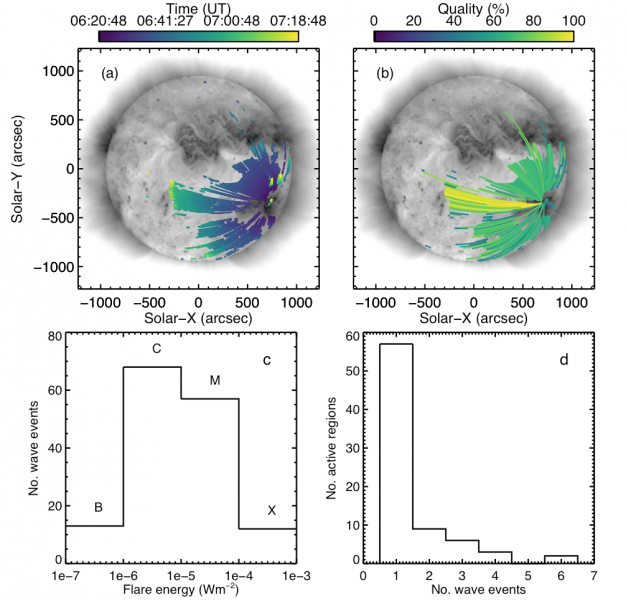Solar eruptions are associated with a variety of different phenomena, including solar flares, coronal mass ejections, Type II radio bursts, solar energetic particles and global coronal EUV waves (commonly known as “EIT waves”, e.g., Warmuth, 2015). However, the relationship between global waves and these other phenomena is not well defined. Although global waves have traditionally been studied using single event case studies, several statistical studies have been performed, with Thompson & Myers (2009), Muhr et al. (2014) and Nitta et al. (2013) collating observations from SOHO, STEREO and SDO respectively.
We used the automated Coronal Pulse Identification and Tracking Algorithm (CorPITA; Long et al., 2014) in this work. This code identifies the global wave in a series of 360 arc sectors, using a quality rating system to quantify the detection and allowing its temporal evolution to be studied; this is shown in panels a and b of Figure 1. CorPITA was applied to a list of 410 global waves previously identified by Nitta et al. (2013) to investigate their statistical relationship with other solar phenomena. We found that of the 362 wave events that could be processed by CorPITA (due to the requirements of the algorithm), 164 were classed as global waves by CorPITA with no waves found for the remaining 198 events.
The classes of the flares associated with each wave are shown in Figure 1, with most waves studied associated with C- and M-class flares. The right-hand panel of Figure 1 shows the relationship between global waves and active regions. Whereas the vast majority of active regions produced one wave event while on disk, 25% produced more than one, with two active regions producing six waves each.

Figure 1. Panel a shows the temporal evolution of the global wave associated with the solar eruption on 7 June 2011 derived using the CorPITA code with colour showing time since 06:20:48 UT. Panel b shows the associated quality rating of each arc sector. Panel c shows the number of waves associated with different flare classes, while panel d shows the relationship between active regions and global waves. Figure modified from Figures 1 and 4 of Long et al. (2017).
No clear relationship was found between the studied waves and associated CMEs as classified using the CDAW LASCO catalogue. However, this is most likely because the associated CMEs would have been travelling towards the observer, making them difficult to identify and correctly analyse. Similarly, only a small subset of the waves studied were found to have associated solar energetic particles as identified using the Wind spacecraft.
The global waves studied were also related to type II radio bursts, with only 40% of the waves studied shown to have an associated type II signature. As shown in Figure 2, there seems to be no relationship between the median wave speed and the presence of a type II, with fast waves having no associated radio burst, while slow waves had associated radio bursts.

Figure 2. Histogram showing the variation in median wave velocity for wave events with and without type II radio bursts. Figure modified from Fig. 6 of Long et al. (2017)
Conclusions
We used an automated technique to perform a purely statistical analysis of the relationship between global waves and other solar phenomena. Although no clear statistical relationship was found between the different features studied, there were some interesting findings. 25% of active regions studied produced more than one global wave while transiting the solar disk while there was no clear relationship between flare class and global waves. Similarly, no relationship was found between the speed of the wave and the existence of a type II radio burst. These results suggest that the structure of the erupting active region and its relationship to the surrounding coronal magnetic field may be more important for determining the presence of a global wave than the amount of free energy available.
Based on the recent paper: Long et al.: A Statistical Analysis of the Solar Phenomena Associated with Global EUV Waves, Solar Physics 292, 185 (2017) DOI: 10.1007/s11207-017-1206-0
Note that the catalogue produced as part of this work is freely available associated with the online version of the published paper.
References
Long, D. M., Bloomfield, D. S., Gallagher, P. T., Pérez-Suárez, D., Solar Physics, 289, 9, (2014)
Muhr, N., Veronig, A. M., Kienreich, I. W. et al., Solar Physics, 289, 12, (2014)
Nitta, N. V., Schrijver, C. J., Title, A. M., Liu, W., The Astrophysical Journal, 776, 1, (2013)
Thompson, B. J. & Myers, D. C., The Astrophysical Journal Supplement, 183, 2, (2009)
Warmuth, A., Living Reviews in Solar Physics, 12, 1, (2015)
*Full list of authors: David Long, Pearse Murphy, Georgina Graham, Eoin Carley, and David Pérez-Suárez
